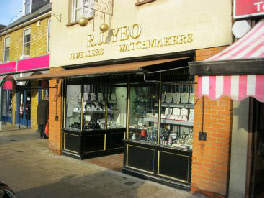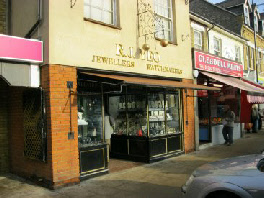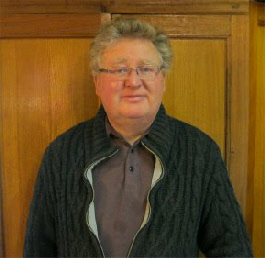Talk to us here at Rochford Life : 0786 342 7294 or E-mail us. For other numbers see individual pages.


Make a point of visiting us weekly! Tell a friend about us.
Rochford Square - “R.J.Yeo”
Jewellers & Watchmakers
Jewellers & Watchmakers
Kenneth J Massow FIRV FGA DGA
R J Yeo
24 West Street, ROCHFORD, SS4 1AJ
Tel: 01702 544712
ken-john.massow@virgin.net
R J Yeo
24 West Street, ROCHFORD, SS4 1AJ
Tel: 01702 544712
ken-
Part 2: Introduction to GOLD
RL: Can you tell us a little about gold
Ken: Gold is at its highest price level since 1979 when we had the last gold boom. It rocketed to an all-time high in the last eighteen months on the back of the financial crisis, because now there is a limit of £50,000 of guarantees money to be held in a bank and if you happen to have more than that, to be secure you need to be in two, three, four different banks. Wealthier people are therefore investing in gold purely because it would appear to be safer than the banks when you consider how many of them have either needed government help or gone bust. We’ve had pension providers go broke and we had insurance companies go broke, so all of this on a world-wide basis is forcing up the price of gold.
What people have to realise is that gold is a world commodity and you can go to places like Dubai and other parts of the world, and the price of gold will be the same wherever you buy. What varies is the manufacturing costs and the retailer’s profit and the local taxes, so if one goes to places like Dubai where the government supply gold at the basic cost, because the wages are very low in those countries, the manufacturing cost is lower. As a lot of people don’t declare on their entry to the UK that they have bought these type of goods, VAT although it is supposed to be paid, is invariably not paid, and that makes goods cheaper, but gold itself is the same price the world over.
RL: Can you say something about carats? (A carat, when used with gold, is a unit of purity)
Ken: In this country, post 1973, we use 9 carat, 14 carat, 18 carat and 22 carats. What that means is that there are 24 parts to the whole of pure gold (in terms of purity for measurement sake), so for 22 carat it means 22 parts are gold and 2 parts are something else, an alloying metal. With 9 carat, 9 parts are gold and 15 parts are an alloying metal. The higher the carat the higher the gold content and the dearer the product.
There are different sectors of the community that have different preferences for gold. Most Asian people would prefer 22 carat gold as purity is part of their religious aspect and the purer the material the better it is. The English, on the whole, prefer 9 carats, primarily because it gives a greater value for money. A 9 carat item is less than half the price of 18 carats.
RL: Can you with your expertise look at a piece of gold and say you know what it is?
Ken: You can in some instances, say if it is 22 carat because 22 carat is the only colour that cannot be duplicated by any other colour. Otherwise all the colours are available in all the karats, the only exception being white gold. If you see white gold in its raw state once it’s been alloyed, but before it’s been finished, you can tell instantly 18 from any other carat of white gold.
All karats of gold, apart from what is called top white 18 carat gold, are pale yellow and the finishing material is something called rhodium plate and the item is rhodium plated to give it a crisp white look. A top white carat gold will be white and it will be white all the way through and it will not have a hint of yellow. Top white gold is difficult to work with, more costly to buy, and so a lot of companies actually use a pale yellow gold because it is cheaper to buy, cheaper to produce, even in 18 carats and the finish that is white is in fact rhodium plate and not white gold.
RL: So why does everybody want white gold?
Ken: It is a fashion trend of the super-models. The super-models took to wearing platinum which is again much denser than gold and the price is higher to start with. It’s a lot more difficult to work with so everything about platinum makes it a much more expensive metal. It was originally used at the turn of the 1900s to make very fine and delicate settings of the Edwardian era.
Platinum has very great wearing capabilities; you can wear it for years and years and it doesn’t show signs of wear and that it is why it is used, to reduce wear and give strength and rigidity. However, in today’s market, because it is so expensive, there is a huge demand for all white metals including palladium which is another of what is called a noble metal of the platinum groups, but is not as expensive and not as dense and so it weighs less than platinum so the gram-price is cheaper and you need less of it.
RL: I never knew these things.
Ken: The Birmingham Assay Office have produced a sheet showing grades of whiteness. We have had people in the shop crying when they have a white wedding or engagement ring and they ask, “What have I done to my ring; it’s gone yellow?” and they haven’t been aware that it isn’t white, and many occasions we’ve actually remade wedding or engagement rings in white materials because you can’t wear anything that is rhodium plated without it wearing over a period of time and turning yellow and needing to be remade white.
When you have someone who is an authority giving advice, it does help for consumers to understand that a small shop like this can actually tell them what white gold is but very large retailers, including high end retailers often cannot, and it isn’t explained when they buy the item. Of course we now have things like Internet shopping channels which offer, in a lot of instances, great choice and great value for money, but the advertising doesn’t seem to be controlled in the same way as high street based shops and you seem to be allowed to claim much greater things, which can cause difficulties.
Top of Page
RL: Can you tell us a little about gold
Ken: Gold is at its highest price level since 1979 when we had the last gold boom. It rocketed to an all-
RL: Can you say something about carats? (A carat, when used with gold, is a unit of purity)
Ken: In this country, post 1973, we use 9 carat, 14 carat, 18 carat and 22 carats. What that means is that there are 24 parts to the whole of pure gold (in terms of purity for measurement sake), so for 22 carat it means 22 parts are gold and 2 parts are something else, an alloying metal. With 9 carat, 9 parts are gold and 15 parts are an alloying metal. The higher the carat the higher the gold content and the dearer the product.
There are different sectors of the community that have different preferences for gold. Most Asian people would prefer 22 carat gold as purity is part of their religious aspect and the purer the material the better it is. The English, on the whole, prefer 9 carats, primarily because it gives a greater value for money. A 9 carat item is less than half the price of 18 carats.
RL: Can you with your expertise look at a piece of gold and say you know what it is?
Ken: You can in some instances, say if it is 22 carat because 22 carat is the only colour that cannot be duplicated by any other colour. Otherwise all the colours are available in all the karats, the only exception being white gold. If you see white gold in its raw state once it’s been alloyed, but before it’s been finished, you can tell instantly 18 from any other carat of white gold.
All karats of gold, apart from what is called top white 18 carat gold, are pale yellow and the finishing material is something called rhodium plate and the item is rhodium plated to give it a crisp white look. A top white carat gold will be white and it will be white all the way through and it will not have a hint of yellow. Top white gold is difficult to work with, more costly to buy, and so a lot of companies actually use a pale yellow gold because it is cheaper to buy, cheaper to produce, even in 18 carats and the finish that is white is in fact rhodium plate and not white gold.
RL: So why does everybody want white gold?
Ken: It is a fashion trend of the super-
Platinum has very great wearing capabilities; you can wear it for years and years and it doesn’t show signs of wear and that it is why it is used, to reduce wear and give strength and rigidity. However, in today’s market, because it is so expensive, there is a huge demand for all white metals including palladium which is another of what is called a noble metal of the platinum groups, but is not as expensive and not as dense and so it weighs less than platinum so the gram-
RL: I never knew these things.
Ken: The Birmingham Assay Office have produced a sheet showing grades of whiteness. We have had people in the shop crying when they have a white wedding or engagement ring and they ask, “What have I done to my ring; it’s gone yellow?” and they haven’t been aware that it isn’t white, and many occasions we’ve actually remade wedding or engagement rings in white materials because you can’t wear anything that is rhodium plated without it wearing over a period of time and turning yellow and needing to be remade white.
When you have someone who is an authority giving advice, it does help for consumers to understand that a small shop like this can actually tell them what white gold is but very large retailers, including high end retailers often cannot, and it isn’t explained when they buy the item. Of course we now have things like Internet shopping channels which offer, in a lot of instances, great choice and great value for money, but the advertising doesn’t seem to be controlled in the same way as high street based shops and you seem to be allowed to claim much greater things, which can cause difficulties.
Top of Page



Continuation of Interview with Ken Massow (Part 2)
As we talked on with Ken we invited him to tell us a little about Gold. We hope this introduction will whet your appetite to find out more. In both this and the following two articles we have highlighted materials that you might like to find out more about using your over Internet search - we were tempted to provide links for them all but concluded you will enjoy it more yourself looking up and chasing down the leads using your own web-browser & favourite search engine. Have fun.
As we talked on with Ken we invited him to tell us a little about Gold. We hope this introduction will whet your appetite to find out more. In both this and the following two articles we have highlighted materials that you might like to find out more about using your over Internet search -